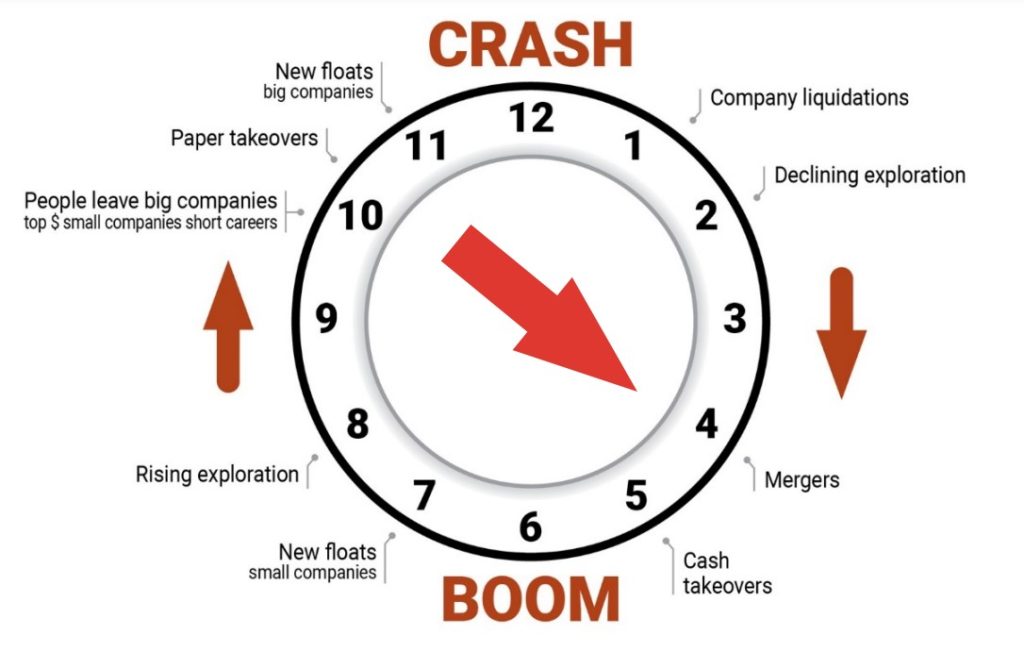
The United State of Mining: Liberation or subjugation, it’s Trump’s Americanisation
A common phrase being bandied around in markets regarding US President Donald Trump is a phrase oft used in the context of stock market investing.: “Sell hubris, buy humiliation.”
The implication being to sell assets or investments that are inflated by excessive confidence and optimism (hubris) and buy those considered undervalued and seemingly ignored by the market – even if it feels like a humbling choice (humiliation) – essentially betting against the current hype by looking for potential bargains not seen by others.
Within this backdrop, Mining.com.au‘s United State of Mining: A North American outlook series has been highlighting themes and trends affecting the market in 2025 including aggressive US protectionism, deglobalisation, and policy uncertainty.
Parts one and two reveal emerging trends in North America include sector consolidation and increased dealmaking, a ramping up of capital raisings and initial public offerings, with critical minerals supply chains other key themes to keep an eye out for in 2025.
Wrapping up the series, Mining.com.au focuses on Trump’s publicised want to annex Canada as the ‘51st state’, implications of his executive order to boost America’s mineral production, and the importance of reallocating resources to high-potential projects in order to strengthen resilience against economic volatility and external pressures.


Tick, tick, boom!
According to Dean McPherson, Head of Global Mining for the TMX Group (TSX:X) – which operates the Toronto Stock Exchange (TSX) and TSX Venture Exchange (TSX-V) – expectations are that this global uncertainty will subside as early adjustments to the new US administration progresses.
McPherson says it’s important to keep focused on the fundamentals and ignore the noise in “emotion-fueled” headlines and rhetoric. The fundamentals say there is a significant gap in the supply and demand for copper (and other critical minerals) and uranium to meet growth/energy transition and technology demands (AI advancement in particular).
“Against the backdrop of improving global macroeconomic performance in the world’s largest markets, mining could be in for an even better performance in 2025,” TMX Group’s Head of Global Mining tells this news service.
As Lion Selection Group (ASX:LSX) CEO Hedley Widdup explains to Mining.com.au, one clear symptom of the Trump spectre over the market is a new uncertainty about what is around the corner.
“I think part of the Trump effect could be forcing investors to re-assess valuations and what they are happy to pay for distant future earnings, and the clearest part of the market that might play out is in big tech,” Widdup says.
“It is connected because a deflating US market that is led down by the magnificent seven becoming the much-more-normal-seven would affect investors everywhere and could become a negative sentiment much more broadly.
“Historically, when markets have been led to exuberance by tech, the beneficiary of a collapse is the commodity sector. This thematic is the basis of my thoughts on what to expect in North America and elsewhere in the mining market, and I think it’s a driver of the mining market and clock towards and then past 6 o’ clock as the next boom starts to take place, over say the next 18 months or so.”
The clock Widdup refers to is the Lion Investment Clock, which is at ‘mergers’ now and is ticking towards ‘cash takeovers’ followed by ‘boom’ time. The clock is universal – it’s the same time for all markets and commodities around the world. Driving this boom-preceding activity, says Widdup, will be cashed-up producers pursuing synergistic bolt-on acquisitions in respective domestic markets to bolster existing operations.


Reducing global economic interdependence
A Sprott Asset Management special report suggests these aforementioned converging forces are driving a shift to reduce global economic interdependence, creating a challenging environment for economic growth and stability.
The pandemic exposed vulnerabilities in global supply chains and fuelled protectionism and nationalism. These vulnerabilities are being compounded by current macroeconomic forces such as aggressive US protectionism, which is tracking to become a key catalyst for deglobalisation in 2025, as reported.
In 2025, there is likely to be a further decoupling between two groups of commodities — the traditional industrial commodities, strongly influenced by China’s economic activity, and those tied to the energy transition, electrification and digitalisation of the US economy.
“This decoupling has been shaped by significant global events in the 2022-2024 period, like the Shanghai covid outbreak and the Russia-Ukraine war. These events exacerbated market volatility, highlighted vulnerabilities in global supply chains and catalysed the shift toward new energy systems. As a result, prices of critical materials commodities have outpaced those of China-led commodities,” Sprott reports.
According to Deloitte, shaping critical mineral supply chains is poised to be a major industry trend in 2025. Balancing growth opportunities with supply chain risks requires clear initiatives, strategic planning, forming strong partnerships, ensuring ethical sourcing, security, and stability to meet market demands and operational challenges.
Element79 Gold (CSE:ELEM) CEO James C Tworek agrees that all commodities appear to be heading into a state of scarcity of supply, scarcity of processing capacity, and increased global demand. This seems especially true for critical mineral supplies around the globe, given certain economies having cut off exports of critical metals and raw materials, disrupting former supply chains and overall accessibility.
While it depends on your perspective of gold and silver being ‘strategic’ or ‘critical’ metals, Element79’s focus is to feed global demand by bringing actual production online and provide some form of feedstock (concentrate, perhaps dore) to the global supply chains in the near term, Tworek tells Mining.com.au.
While shaping critical mineral supply chains are emerging as a major theme this year, Questcorp Mining (CSE:QQQ) is seeking to diversify, restructure, and stick to geopolitically safe countries and continents.
“Management have been working towards reallocating resources for some time now and that is why the companies have taken the steps it believes are necessary for the long term success and potential ROI for investors is to be reflected over the couple of years,” CEO Saf Dhillon tells this news service.
Copper Lake Resources (TSX-V:CPL) CEO Terry MacDonald believes the critical minerals strategy will not only be a key component of the Canadian mining industry in 2025 but also through 2026.
“Much of the focus over the past couple of years has been on the development of upstream infrastructure such as battery plants and roads, etcetera. However, I believe that the emphasis in the next 12 to 24 months will be on exploration and securing the sources of the critical minerals, which has been neglected over the past decade,” the CEO says.


America first mandate
On 20 March, US President Donald Trump signed an executive order to boost American mineral production, streamline permitting, and enhance national security. Minerals covered by the order include critical minerals, copper, gold, potash, uranium, and any other element, compound, or material as determined by the Chair of the NEDC, such as coal.
Under the ‘Immediate Measures to Increase American Mineral Production’ order, agencies will compile a list of all mineral production projects that have submitted a plan of operations, permit application, or any other approval request to that agency in order to expedite the review and advancement of those projects in coordination with the National Energy Dominance Council (NEDC).
The Secretary of the Interior will prioritise mineral production activities over other types of activities on federal land that hold critical mineral deposits. The Defense Production Act (DPA) will be used to expand domestic mineral production capacity.
Financing, loans, and investment support will be provided for new mineral production projects, including a dedicated critical minerals fund established through the United States International Development Finance Corporation in collaboration with the Department of Defense.
Demand for critical minerals has been dubbed the ‘gold rush of the 21st century’ due to their importance in emerging technologies.
Trump’s executive order is based on the US currently importing a significant portion of its minerals from foreign countries, despite possessing a vast supply of critical minerals. The US is import-reliant on at least 15 critical minerals and imports of nonfuel mineral commodities make up more than half of the country’s consumption.


The 51st state
It’s largely why Trump keeps talking about making Canada the 51st state.
Canada, much like Australia, is well-endowed with natural resources, including critical minerals. The north of both countries are rich in resources yet have somewhat underdeveloped infrastructure. They are sparsely populated where large proportions of the inhabitants are indigenous. Both are large physical areas with similar geopolitical environments and are well-endowed with minerals and resources.
In his first speech after winning the race to lead Canada’s governing Liberal Party, Mark Carney took direct aim at President Trump and his publicised want to annex Canada as the ‘51st state’. Undoubtedly, the President’s comments have conjured up a range of emotions among all Canadians.
Element79 Gold CEO James C Tworek understands the US’ desire to access the bounty of natural resources in Canada, “to protect its borders from drugs and dare I say Communist or Socialist threats”, as well as gain access to the Northern Passage through ownership of Canada.
“Having said that, I’m a proud Canadian that has lived in both the East and West and think that it’s a beautiful country that is going through a major upheaval and identity crisis at the moment, spurred by abusively misguided leadership over the past decade. Change is good, but giving up sovereignty of a once-great nation just because someone else wants it like a shiny new toy isn’t the answer, new leadership here in Canada and rewriting diplomacy is,” Tworek tells Mining.com.au.
In terms of Trump’s rhetoric affecting the North American mining sector, Tworek can only hope it will spur further development of both existing assets, create new production (milling, smelting, refining) capacity and new jobs in the mining industry, whether in densely-populated areas or in the hinterland.
Questcorp’s Dhillon says such comments show the ‘businessman Donald Trump’ sees value in wanting Canada to be a part of the US. The Trump Presidency has highlighted the fact that Canada is an extremely resources rich country that hasn’t nearly begun to show its true potential.
“If he didn’t see any value in us (Canada) he’d want to distance himself from us rather than want to absorb us into the family,” Dhillon adds.
“President Trump realises the natural resources wealth Canada holds and understands the key to wealth for the citizens of the country is utilising its endowment”
Elaborating on this sentiment, Dhillon’s colleague Director Tim Henneberry notes Trump’s interest spurs from Canada being rich in natural resources, albeit within an “antidevelopment administration that believes they should be locked up”.
“President Trump realises the natural resources wealth Canada holds and understands the key to wealth for the citizens of the country is utilising its endowment. He is giving Canadians a wake up call that should be heeded,” Henneberry continues.
“The Trump presidency will help explorers and developers in the US as the administration is pro-business and development and understands the importance of domestic sources of natural resources and should also curtail red tape around permitting and development.”


Cutting red tape
Some executives are critical of Canada’s government curtailing growth opportunities through burdensome red and green tape. But these issues are not confined to North America. An S&P Global examination of average times for mines to come online around the world found it took an average of 17.9 years in 2020–23, compared to just 12.7 years for some mines that started operations before 2009. In Canada, the average timeframe to start operations was around 18 years, which aligns with global trends.
While Canada and Australia are similar in terms of government structures and permitting processes, shortening timelines to permitting mines allows projects to launch faster and have a more immediate impact on the economy, decreasing timeframes for investor returns and bolstering confidence for current and future projects.
Considering there are more than 1,000 listed mining companies on the TSX and TSX-V with “40% of all the money raised in the world for mining going through Toronto”, Trojan Gold (CSE:TGII) CEO Charles J Elbourne says Canada should be the benchmark and leader in this regard.
Elbourne notes these delays hamper initiation of new mining projects and deter potential investors, affecting the mining sector’s growth, economic prospects, and overall valuations.
As any junior explorer will attest – the small end of town is inherently undervalued.
Despite this, any mining executive listed on the Canadian stock exchanges will tell you they’re inherently undervalued. Elbourne suggests the market could be at an inflection point in this regard.
“I think we’ve definitely seen the bottom in the junior mining market. It’s just that the public has not taken any interest in it yet to speak of. But I’ve got an old saying that ‘The public is always right in the middle and wrong at both ends’ when it comes to the stock market,” Elbourne tells this news service.
“I follow the market very much. I think the Dow (Jones) has got a double head on it now, and I think it’s going to crash.”
Trojan Gold’s CEO says an ailing real estate market in certain parts of the US has dropped almost 40%, mirroring the period from 2006 through 2008 when everything crashed, culminating in the global financial crisis (GFC).
“Same crap, same stuff happening. So when you look at the market right now, I’m absolutely convinced the junior market has bottomed. It’s just there’s no traction by retail investors. And part of the reason for that is when marijuana stocks – and marijuana was approved here in Canada – all the money that would normally be going into junior mining went into the marijuana stocks. That’s what happened … 90% of them lost their money.”
As Questcorp’s Dhillon notes, however, there are still plenty of opportunities for growth. But with the tightening of liquidity in recent years investors are lacking the confidence to back such micro-cap sized companies until they start achieving stated milestones.
Dhillon’s perspective reflects the findings of a report issued by professional services firm Deloitte, which states active portfolio management and strong senior leadership commitment are essential for adapting to market changes.
Reallocating resources
Element79 Gold (CSE:ELEM) CEO James C Tworek says reallocating resources to high-potential projects and pursuing long-term goals in order to strengthen resilience against economic volatility and external pressures has been the driving force in his company’s current business model. Under this strategy, Element79 has pivoted away from a portfolio aggregation phase (growing from one to 20 projects in under two years) into a production-focused model.
“Let’s be honest – to clearly articulate the value of one core project is difficult enough in a 15-20 minute discussion, and to try to discuss 20-plus projects is (in my opinion) impossible. We have pared down from 20 to currently one project with the intent of bringing Lucero, a past-producing high-grade gold and silver mine back into commercial production in the near term,” he says.
Element79 in late April is aiming to complete community negotiations that include a long-term surface rights access permit at the Minas Lucero Project. As part of its commitment to responsible mining and sustainable development, Element79 Gold’s local team has been actively engaging with community leaders and stakeholders in Chachas and surrounding annexes at the project, which is located in the Arequipa region of Peru.
With the US President rolling out his tariffs on various commodities and countries unabated, American Salars Lithium (CSE:USLI) is one company hedging its portfolio to avoid getting caught up in the fallout. With the potential for new tariffs on lithium imports under the Trump administration, the Vancouver-based company has positioned itself to secure a stable, tariff-free lithium supply through its Black Rock South Lithium Project in Nevada.
The project is located around 116km north of the Tesla Gigafactory, 150km southwest of Lithium Americas’ (TSX:LAC) Thacker Pass mine — which is the most advanced development-stage lithium project in Nevada — and 346km northwest of the US’ only producing lithium operation, the Silver Peak lithium brine mine owned by Albemarle (NYSE:ALB).
Beyond its Nevada project, American Salars has acquired a diversified portfolio of lithium assets in Canada, Brazil, and Argentina, positioning the company for potential resource development and enhanced market flexibility amid shifting global trade policies.
American Salars is strengthening its footprint in Argentina’s Lithium Triangle, a globally recognised region containing some of the highest-grade lithium brine deposits. The company says this strategic positioning enhances its potential for future exploration and development in one of the world’s most significant lithium-producing areas.
American Salars CEO Nick Horsley states: “The lithium market is evolving rapidly, and shifting trade policies could create new challenges. By securing strategic lithium assets in key regions of North and South America, we have hedged ourselves geopolitically to meet the growing demand driven by electric vehicles and renewable energy storage.”
“This strategy reduces our exposure to uncertain supply chains and trade war implications”
“This strategy reduces our exposure to uncertain supply chains and trade war implications. Amid the tariff war, talk of Argentina and the United States entering a trade pact bodes well for our Salar de Pocitos flagship project, positioning it as a critical asset in a stabilising Western supply chain, especially as US policies increasingly prioritise domestic and allied sourcing of critical minerals.
“As trade uncertainties grow, American Salars Lithium’s Nevada property serves as a critical safeguard against rising costs and potential supply chain disruptions. By owning and developing a US-based lithium source, the company guarantees a reliable, domestic supply of lithium, reducing exposure to geopolitical risks and import restrictions. This strategic positioning not only strengthens American Salars Lithium’s role in the US lithium market but also supports North America’s push for energy independence in the face of shifting trade policies.”
As Peak Asset Management founder Niv Dagan explains, there are other trends to look out for in 2025 for miners in Australia and North America.
“It’s all about the USD and the 10-year bond yields. We feel that Trump is purposely pushing for a recession, in order to drive US yields lower. We have to remember that the US has over US$7 trillion of debt maturing in 2025 and hence, if he can refinance this debt at lower interest rates, the market will bounce strongly,” Dagan says.
“This is driving inflows towards gold, silver, and copper – on the back of a ‘flight to safety’ and US tariffs.”
TSX Group’s Head of Mining Dean McPherson is using sentiment at PDAC 2025 – the largest gathering for the global mining sector – as the benchmark for forecasting the year ahead.
“Our takeaway was that this year the general sentiment was one of optimism for the global mining sector and its continued recognition as a critical source in not only energy transition but global development and growth in general. This year there was a wider field of country delegations, with Saudi Arabia, Uzbekistan and the Baltic nations joining African and Latin American delegations,” McPherson tells Mining.com.au.
“Mining is certainly now being recognised as a global critical sector. Shadowing this optimism was the uncertainty as the impact of tariffs and impending trade wars was ever present and being discussed throughout the various panels and receptions. So perhaps, ‘cautiously improving optimism’ is the best way to describe the sentiment.”
Write to Adam Orlando at Mining.com.au
Images: Mining.com.au, iStock & Unsplash